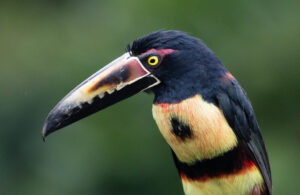Nestled deep within the lush jungles of Belize, a formidable predator reigns supreme – the Harpy Eagle. With its massive size, striking appearance, and unparalleled hunting skills, the Harpy Eagle stands as one of the most majestic birds of prey in the world. In this article, we delve into the fascinating world of these magnificent creatures, exploring their anatomy, hunting strategies, and the challenges they face in a rapidly changing environment. Join us on a journey to uncover the secrets of Belize’s Harpy Eagles, the guardians of the jungle.
The Harpy Eagle: Anatomy and Appearance
The Harpy Eagle, scientifically known as Harpia harpyja, is a magnificent creature that commands attention with its imposing size and distinctive features. As one of the largest and most powerful eagles globally, it boasts an impressive wingspan of up to 7 feet (2.1 meters) and can weigh anywhere from 10 to 20 pounds (4.5 to 9 kilograms). These massive dimensions make the Harpy Eagle a formidable presence in the skies above Belize’s dense forests.
One of the most striking aspects of the Harpy Eagle is its appearance, characterized by a striking crown of feathers atop its head, giving it an almost regal and mythical aura. Its plumage is predominantly gray, with a contrasting white underside and black bands on its tail. These colors blend seamlessly with the dappled sunlight filtering through the canopy, providing excellent camouflage during hunting expeditions.
The Harpy Eagle’s facial features are equally impressive, with piercing yellow eyes that exude intelligence and focus. Its strong, curved beak is designed for tearing through tough prey, showcasing its role as a top predator in the ecosystem. Powerful talons, as long as grizzly bear claws, further enhance its hunting prowess, allowing it to snatch prey mid-flight or from the treetops with unparalleled precision.
In addition to its physical attributes, the Harpy Eagle’s vocalizations are equally remarkable. Its calls range from deep, resonant hoots to piercing screeches, serving as communication signals within its territory and during courtship displays. These vocalizations add to the mystique surrounding this majestic bird, further solidifying its status as a symbol of strength and wilderness in Belize’s rich biodiversity.
Overall, the Harpy Eagle’s anatomy and appearance showcase a perfect blend of grace, power, and adaptability, making it a true marvel of nature that continues to captivate researchers, conservationists, and wildlife enthusiasts alike.
Hunting Strategies of the Harpy Eagle
The Harpy Eagle’s status as a top predator in Belize’s jungles is not merely due to its size and strength but also stems from its highly effective hunting strategies. With keen eyesight, exceptional agility, and specialized adaptations, the Harpy Eagle is a masterful hunter capable of targeting a diverse range of prey.
One of the Harpy Eagle’s primary hunting strategies is perch-hunting, where it perches high in the canopy, patiently scanning the surroundings for potential prey. Its incredible vision allows it to detect movement from considerable distances, enabling it to spot small mammals, birds, and even reptiles moving through the foliage below. Once a target is identified, the Harpy Eagle swiftly launches into action, diving down with impressive speed and accuracy to seize its prey with its powerful talons.
Another notable hunting technique employed by the Harpy Eagle is ambush hunting. Utilizing its superb camouflage and stealthy approach, the eagle positions itself strategically near known feeding areas or along game trails frequented by prey. When an unsuspecting animal comes within striking range, the Harpy Eagle launches a surprise attack, often catching its prey off guard and securing a successful kill.
The Harpy Eagle’s physical adaptations further enhance its hunting prowess. Its large, curved talons are designed to deliver lethal blows, capable of puncturing through thick fur, feathers, and even tough reptilian scales. These talons act as formidable weapons, ensuring that once the Harpy Eagle makes contact with its prey, escape becomes nearly impossible.
Interestingly, the Harpy Eagle is also known for its cooperative hunting behavior in certain situations. In some instances, pairs or family groups may collaborate during hunts, increasing their chances of securing larger prey or tackling more challenging targets.
Overall, the Harpy Eagle’s hunting strategies exemplify a perfect balance of patience, precision, and predatory instincts, allowing it to thrive as a top predator in Belize’s intricate ecosystems. Studying and understanding these strategies is crucial for conservation efforts aimed at preserving this magnificent species and its vital role in maintaining ecological balance.
Conservation Efforts and Challenges for the Harpy Eagle in Belize
Despite its formidable presence and ecological significance, the Harpy Eagle faces numerous challenges in Belize, primarily stemming from habitat loss, human-wildlife conflict, and illegal activities. Conservation efforts aimed at protecting this iconic species are crucial for ensuring its survival and maintaining healthy ecosystems.
One of the primary challenges confronting Harpy Eagles in Belize is habitat destruction due to deforestation and land conversion for agriculture, logging, and infrastructure development. As their forest habitats shrink, Harpy Eagles face reduced prey availability, nesting sites, and territorial space, leading to increased competition and stress within the population.
Human-wildlife conflict poses another significant threat to Harpy Eagles in Belize. Encounters with humans, whether through accidental entanglement in hunting snares, electrocution from power lines, or intentional persecution due to misconceptions and fear, can result in injuries or fatalities for these magnificent birds. Education and community outreach programs are essential in fostering coexistence and reducing conflicts between humans and Harpy Eagles.
Furthermore, illegal activities such as wildlife trafficking and poaching pose serious risks to Harpy Eagle populations. The demand for exotic pets, feathers, and body parts drives illicit trade networks, putting these birds at risk of being captured from the wild or killed for their valuable assets. Strengthening law enforcement and implementing strict regulations are crucial steps in combating illegal activities and protecting Harpy Eagles from exploitation.
Despite these challenges, conservation efforts are underway to safeguard Harpy Eagles in Belize. Collaborative initiatives involving government agencies, conservation organizations, local communities, and researchers focus on habitat restoration, anti-poaching measures, and public awareness campaigns. Establishing protected areas and wildlife corridors also plays a vital role in creating safe havens for Harpy Eagles and promoting biodiversity conservation.
By addressing these conservation challenges and fostering sustainable coexistence between humans and wildlife, Belize can ensure a brighter future for the majestic Harpy Eagle and contribute to the preservation of its natural heritage for generations to come.
Final Thoughts:
The Harpy Eagle’s presence in Belize’s jungles represents not just a symbol of power and beauty but also a crucial indicator of the health of its ecosystems. As we reflect on the anatomy, hunting strategies, and conservation challenges facing these magnificent birds, several key takeaways emerge.
Firstly, the Harpy Eagle’s unique adaptations and hunting prowess underscore its role as a top predator, contributing to the ecological balance of Belize’s forests. Understanding and appreciating these aspects are essential for conservation efforts aimed at protecting not just the eagles but the entire web of life they support.
Secondly, the conservation challenges confronting Harpy Eagles highlight the urgent need for collaborative action. From habitat preservation and mitigating human-wildlife conflicts to combating illegal activities, concerted efforts involving governments, communities, and conservation organizations are crucial in securing a sustainable future for these iconic birds.
Lastly, the plight of the Harpy Eagle serves as a reminder of our interconnectedness with nature. By valuing and respecting wildlife, fostering responsible stewardship, and promoting conservation education, we can create a harmonious coexistence where humans and wildlife thrive together.
As we look ahead, let us remain committed to preserving Belize’s rich biodiversity, with the Harpy Eagle standing as a symbol of resilience, strength, and the enduring beauty of our natural world.




